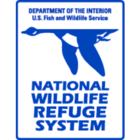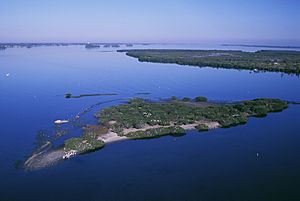National Wildlife Refuge facts for kids
Quick facts for kids National Wildlife Refuge System |
|
|---|---|
|
IUCN Category IV (Habitat/Species Management Area)
|
|

Official logo
|
|
| Location | |
| Area | 859 million acres |
| Established | 1903 |
| Visitors | 65 million (in FY 2022) |
| Governing body | U.S. Fish and Wildlife Service |
The National Wildlife Refuge System (NWRS) is a special network of lands and waters across the United States. It's managed by the United States Fish and Wildlife Service (FWS). This agency is part of the Department of the Interior. The main goal of the NWRS is to protect and conserve America's amazing fish, wildlife, and plants.
President Theodore Roosevelt created the very first wildlife refuge in 1903. It was Florida's Pelican Island National Wildlife Refuge. Since then, the system has grown a lot! Today, there are over 568 national wildlife refuges and 38 wetland management districts. Together, they cover about 856 million acres (about 3.5 million square kilometers).
Contents
What is the National Wildlife Refuge System?
The main job of the refuge system is to manage a national network of lands and waters. This is done to protect and restore fish, wildlife, and plants. It also helps their natural homes, called habitats, across the United States. This work benefits everyone, now and in the future.
The system makes sure these natural places stay healthy and full of different kinds of life. People can also enjoy these areas. This is allowed as long as it doesn't harm the conservation efforts.
What Kinds of Habitats Do Refuges Protect?
National Wildlife Refuges protect many different types of habitats. These include:
- Wetlands, which are like swamps or marshes
- Prairies, which are large grassy areas
- Coastal and marine areas, near oceans
- Temperate, tundra, and boreal forests
Managing each habitat is a complex process. It involves controlling or removing plants and animals that don't belong there. It also means using controlled fires to keep the land healthy. Making sure there's enough water is also important. They also check for outside dangers like new buildings or pollution.
How Do Refuges Help Animals?
Hundreds of national refuges are home to many different species. They protect about 700 types of birds and 220 types of mammals. There are also 250 reptile and amphibian species. More than 1,000 types of fish live there too.
Protecting endangered species is a top priority. Nearly 60 refuges focus mainly on saving 280 threatened or endangered species.
What Can You Do at a Wildlife Refuge?
The National Wildlife Refuge System welcomes about 65 million visitors every year. People come to enjoy outdoor activities. The system allows six main types of activities that depend on wildlife:
- Hunting
- Fishing
- Birding (watching birds)
- Photography
- Environmental education
- Environmental interpretation (learning about nature)
More than 350 refuges offer hunting programs. Fishing is available at over 340 refuges. You can find at least one wildlife refuge in every U.S. state.
Who Works at the Refuges?
Employees at the National Wildlife Refuge System do many important jobs. They plan how to manage the land and monitor animals and plants. They work to protect habitats and manage pollution. They also help visitors and teach people about nature. Some operate heavy equipment, enforce laws, and manage fires.
What Challenges Do Refuges Face?
The National Wildlife Refuge System faces several challenges. These include:
- Cities growing into natural areas
- Habitats getting broken into smaller pieces
- Water quality and quantity getting worse
- Climate change
- Invasive species (plants or animals that harm the environment)
- More people wanting to use the refuges for fun
- More demand for energy development
Despite these challenges, the system has done a lot of good. It has provided homes for endangered species and migratory birds. It has also protected important lands and led efforts to restore habitats.
How Are Refuges Planned and Managed?
The NWRS creates special plans for each refuge. These are called Comprehensive Conservation Plans (CCPs). They are made with help from many different groups and people. These plans outline goals for each refuge for the next 15 years. They are reviewed and updated regularly.
The planning process involves public meetings to hear people's concerns. Refuge staff then identify key issues and goals. They write a draft plan, which the public can review. After getting feedback, they revise the plan and then put it into action.
Each CCP must follow the National Environmental Policy Act (NEPA). This means they must consider different ways to manage habitats and wildlife. They also have to look at how these choices might affect the refuge. NEPA requires staff to involve the public in this planning. This helps them choose the best options.
You can find the completed CCPs on the FWS website.
History of the Refuge System
To learn more about the history of these special places, you can check out the main article:
.
How Refuges Are Managed
Managing wildlife and habitats needs a lot of scientific information. This includes understanding how nature works and keeping track of fish, wildlife, and plants. It's also important to understand how people and the economy affect management decisions.
The refuge system works with many different groups. These include other government agencies, state wildlife groups, tribes, and local landowners. They also work with community volunteers and other partners. This teamwork helps them protect wildlife and their homes more effectively.
What Management Activities Happen at Refuges?
Wildlife and habitat management activities include:
- Monitoring animal and plant populations
- Restoring wetlands, forests, grasslands, and marine habitats
- Controlling invasive species
- Bringing back rare fish, wildlife, and plants to areas where they used to live
- Checking air quality
- Investigating and cleaning up pollution
- Preventing and controlling wildlife diseases
- Checking water quality and how much water there is
- Understanding how people and wildlife interact
- Managing habitats by changing water levels, using controlled burns, or planting new vegetation
In one recent year (2015), the refuge system actively managed 3.1 million acres of habitat. They also protected 147 million acres without direct habitat changes.
- Uplands (higher ground) managed: 1.9 million acres
- Wetlands managed: 1.0 million acres
- Open water managed: 0.2 million acres
- Areas treated by controlled burning: 0.3 million acres
- Areas treated to control invasive plants: 0.2 million acres
- Protected but not actively changed: 147 million acres
How Do Refuges Help Local Economies?
Refuges attract about 65 million visitors each year. People come to hunt, fish, watch, and photograph wildlife. These visits are a big help to local economies.
According to a 2013 report, visitors to refuges had a positive impact:
- They created $2.4 billion in sales for local businesses.
- They supported over 35,000 jobs.
- They generated $342.9 million in taxes for local, state, and federal governments.
- They added a total of $4.5 billion to the nation's economy.
Who Keeps Refuges Safe?
The refuge system has professional law enforcement officers. They help protect the fish, wildlife, and historical sites. They also teach the public about the FWS mission. They keep visitors safe and help local communities during emergencies. They also work with other law enforcement groups on border security.
Preventing and controlling wildfires is also a big part of refuge management. They do controlled burns to reduce fire risks. They also help with larger wildfire fighting efforts.
What Structures Are at Refuges?
Refuges have many physical structures to help with management. As of 2019, they had:
- 15,257 roads, bridges, and trails
- 5,204 buildings
- 8,407 water management structures
- 8,414 other structures like fishing piers and observation decks
The total value of these structures is over $36 billion.
Physical Features of the System
- Total land and water managed: 856 million acres
- Number of management units: 568 refuges, 38 wetland management districts, 5 marine national monuments
- Number of wilderness areas: 74
- Area of wilderness: 20.7 million acres (about 20% of all federal wilderness)
- Length of rivers in the Wild and Scenic Rivers System: 1,086 miles (1,748 km)
- Length of refuge boundary with Mexico: 120 miles (190 km)
Most of the refuge system's area is in Alaska and in large marine areas in the Pacific and Atlantic Oceans. However, most of the individual refuges and visitors are in the lower 48 states. These refuges make up only about 2% of the system's total area.
| Geographic area | No. of units | Size of NWRS (Sept 30, 2022) | Notes |
|---|---|---|---|
| State of Alaska | 16 | 76.8 million acres | 9% of the total Refuge System area is in Alaska. 18% of Alaska is national wildlife refuges. |
| Hawaii and Pacific Marine Areas | 27 | 759.7 million acres | About 88% of the system's acres are in 5 Marine National Monuments. These are mostly coral reefs and open ocean. |
| Puerto Rico, Virgin Islands, Navassa NWR | 9 | 0.4 million acres | The largest refuge here is Navassa Island, nearly 365,000 acres. |
| Lower 48 states | 559 | 19.1 million acres | 2% of NWRS acres are in the lower 48 states. 92% of refuges are in the lower 48 states. |
| Entire refuge system | 611 | 856 million acres | This includes 568 refuges, 38 wetland management districts, and 5 marine national monuments. |
The refuge system has grown in many ways. About 151 million acres of traditional refuges and wetland districts were acquired like this:
- 93% (140 million acres) came from public lands or other federal agencies.
- 4% (6 million acres) were bought using money from the "Duck Stamp" program.
- 1.14% (1.7 million acres) were bought with funds from the Land and Water Conservation Fund.
- 0.46% (694 thousand acres) were bought with other funds.
- 1.13% (1.7 million acres) were given as donations.
How Many People Visit Refuges?
- Wildlife observation visits in 2021: 41.7 million
- Nature photography visits in 2021: 15.1 million
- Fishing visits in 2021: 8.0 million
- Interpretive program visits in 2021: 2.5 million
- Hunting visits in 2021: 2.5 million
- Environmental education visits in 2021: 0.4 million
- Other visits in 2021: 10.9 million
- Total visits in 2021: 65 million
How Many Volunteers Help?
- Total volunteers in 2014: 36,000
- Total volunteer hours in 2014: 1.4 million
How Many Staff Work at Refuges?
- Total staff: 2,424 full-time employees (2022)
- Number of Federal Wildlife Officers: 214
- Number of firefighters: 460 (360 permanent and 100 temporary)
Special Designation Areas
Some lands within refuges have extra special recognition. This can be through laws or administrative actions. These special designations can affect how the refuge lands are managed.
As of 2014, special designation areas within the refuge system included:
- Biosphere reserves (3 units)
- Maine Protected Areas (106 units)
- National Historic Landmarks (10 units)
- National Monuments (7 units)
- National Natural Landmarks (43 units)
- National Recreation Trails (72 units)
- National Wild and Scenic Rivers (13 units)
- Ramsar wetlands of international importance (26 units)
- Research natural areas (207 units)
- Western Hemisphere Shorebird Reserve Network (19 units)
- Wilderness areas (74 units) (the system has 20.7 million acres of wilderness)
- World Heritage sites (1 unit)
List of Refuges
You can find a full list of refuges here:
See also
 In Spanish: Refugio nacional de vida silvestre para niños
In Spanish: Refugio nacional de vida silvestre para niños


